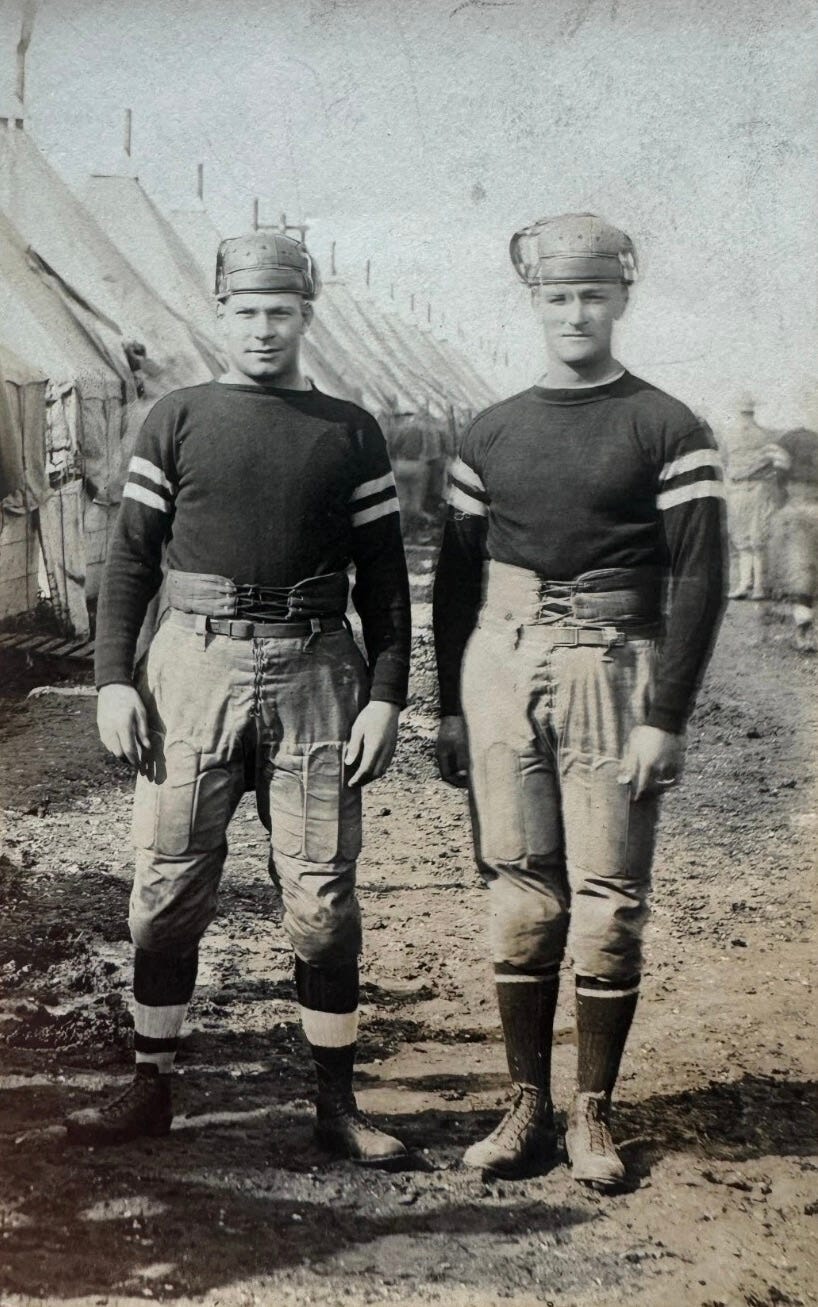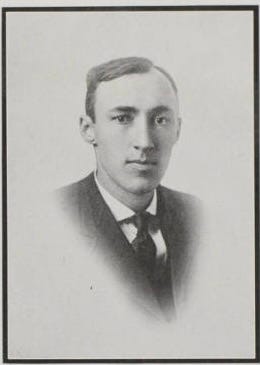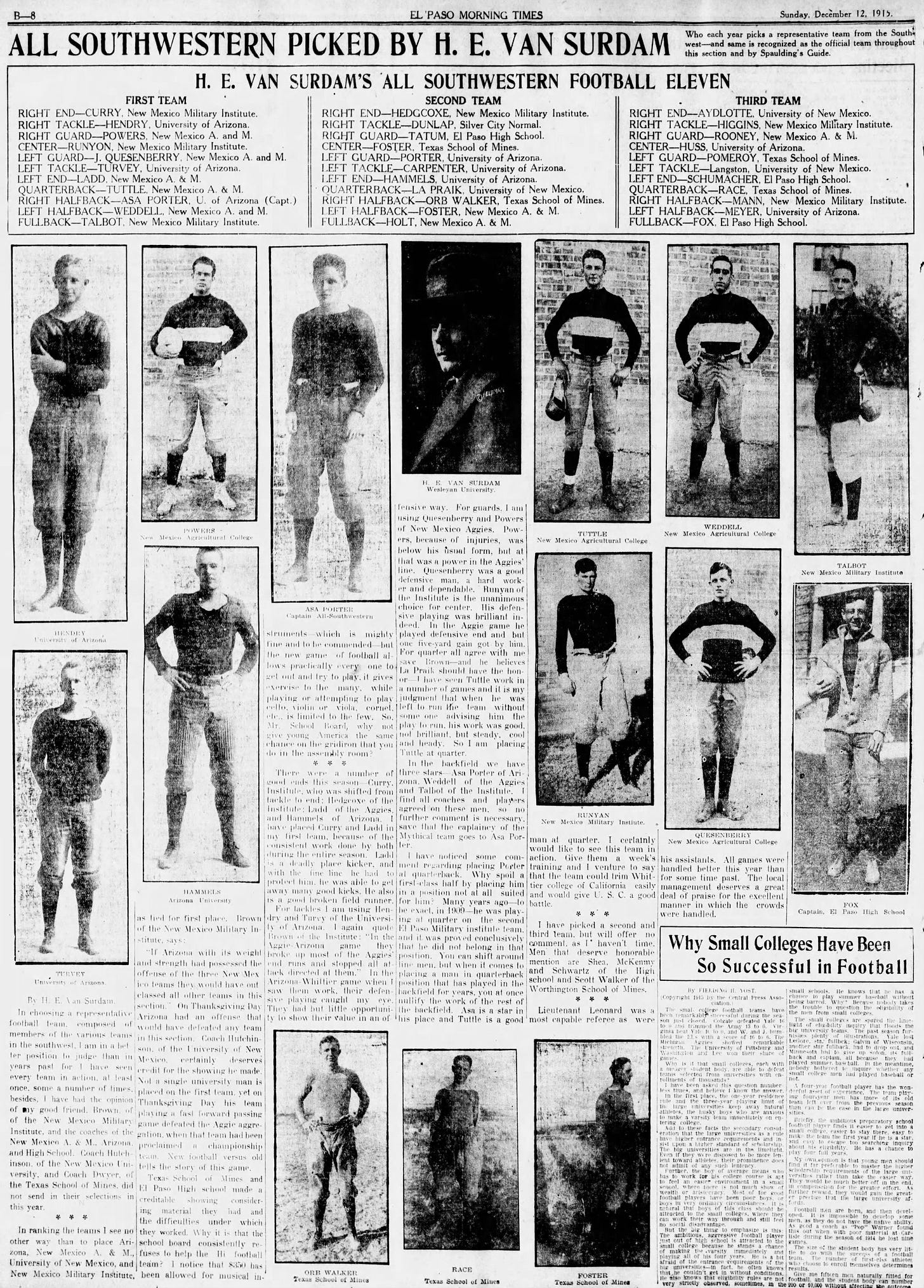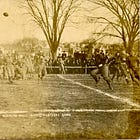The New Mexico State-El Paso High School Battles
Football fans sometimes argue about colleges that played football in the distant past including in their all-time records victories over high schools, athletic clubs, and military teams. Some of the criticism is deserved, but much stems from misunderstanding football back in the day. In early football, college rosters often had players who had never played the game before going to college, while high schools and others might have players well-schooled in the football arts.
I came across one of those examples when I acquired an RPPC from 1915 showing two players from Texas' 20th Infantry, a state militia force deployed along the Mexican border, to keep Pancho Villa out of the U.S., with more or less or less success.

Militia or National Guard units played a lot of football along the border in 1915 and 1916. While I came across a few mentions of 20th Infantry games, they were less common than references to some 20th Infantry officers refereeing the second game of the year between the New Mexico State Aggies and El Paso High School, which were 45 miles apart.
New Mexico State can be forgiven for playing El Paso High twice, largely because there were not many teams worth playing in that neck of the desert, especially since the militia teams put their footballs away and were doing militia things that fall.
New Mexico State Aggies' coach in 1915 was Clarence W. Russell, who played guard for Stagg's great Chicago teams of 1904 to 1906, while also captaining the track team. He coached West Virginia in 1907 and Colorado Mines in 1908, before doing tours with Onalooska High in Iowa and Long Beach Poly. He took over at New Mexico State in 1914 when the team went 4-2-1, splitting a two-game series with El Paso High.
The first game of the 1915 season came on October 3 in Las Cruces, when the prepsters bested the Aggies 6-0 by scoring with two minutes left. The Aggies thought the officiating was poor, with some rough stuff marring the game until they booted one of the high schoolers for his dirty deeds. Others thought the Aggies were out of shape, contributing to their wearing down and giving up the late score.
Two weeks later, the Aggies beat the 4th Artillery 2-0, so they looked forward to their first offensive score of the season in their rematch in El Paso.
The Aggies were ready for bear that day, pushing the ball down the field three times in the first quarter for touchdowns. They capped off the day with a fourth-quarter touchdown on a bad punt snap by El Paso, resulting in a 27-0 win. So, for the second year in a row, the Aggies lost to El Paso High in the first game of the season while winning the second.
As the Aggies' 1916 yearbook tells us, the team turned its attention to the games that really counted, those that allowed them to claim the Southwest championship.
First up for the Aggies was a walk in the park as they defeated the Texas School of Mines, now the University of Texas El Paso, 33-0. It was only the second year the Miners' school and football team existed, and they were dominated accordingly.
A big battle with Arizona followed, with the Aggies coming out on top 3-0. Having won that game, they focused on the New Mexico Military Institute. NMMI had beaten the University of New Mexico, so there was concern about the outcome, but the Aggies prevailed 17-7.
That meant the only barrier in the way of the Aggies claiming the Southwest championship was their Thanksgiving opponent, New Mexico, who lost to a team the Aggies had beaten.
Now, you might think the transitive guaranteed an Aggie win, but it did not, and the Aggies did not (win). Instead, the state university boys beat them 13-0. The loss to New Mexico left claims to the Southwestern championship unsettled, but the 1916 New Mexico State yearbook claimed their share nonetheless.

Remember, this story started with the issue of college teams playing high schools and counting those games in their all-time records. The comparability of high school and college teams in the Southwest in 1915 is made clear by El Paso High School beating New Mexico State in back-to-back years. Still, the comparison is made clearer when you realize that the All-Southwest team for 1915 included not only players on the college teams discussed in this story, but also the boys who played for El Paso High.

The full article covering the All-Southwestern team is below.
Some readers might recognize H. E. Van Surdam's name. He is the guy some incorrectly claimed threw the first forward at Marietta College, which I wrote about earlier this week.
Van Surdam had made his way west to coach the El Paso Military Academy team. When the school went belly up in 1914, the campus became the Texas School of Mines, now The University of Texas El Paso.
Clarence Russell coached New Mexico State in 1916 before returning to California, where he died of the Spanish Flu in 1919.
El Paso High and the Aggies played again in 1917 and may have played since then, but high schools and colleges increasingly went their separate ways. Still, the El Paso High Tigers can take pride in beating a college team two years in a row back before the Big One.
Click here for options on how to support this site beyond a free subscription.






Just reading "The Crossing," a new history of El Paso. Did my graduate work at New Mexico State. UTEP (Texas Western, aka School of Mines and Metallurgy and UTEP) is, of course best known for its National Basketball Championship under Bear Haskins. That was in 1966, the year Notre Dame won the championship in football.
I spent some time at UTEP doing an Air Force ROTC gig. The campus chief of police told the story about being a young officer on the force. The students had gathered on campus to celebrate the victory, but didn't really know what to do. The lieutenant who was telling them to go home over a squad bullhorn was showered with bottles. The cub officer told him to get out of there. He then took the mike and said, "We're going to have a parade. Follow the squad car." He drove around the campus, leading the crowd. Eventually they all got tired and went home. This part of the story does not make it into "The Crossing."
Since you love stories, I'll tell about getting on the freeway in El Paso and seeing the familiar green sign, "Lac Cruces, 37 Miles." After a day of teaching and taking classes, I'd get back on the same expressway and read the green sign, "El Paso, 42 miles." Wait, what? Finally somebody explained the discrepancy. Las Cruces is small. El Paso, winds around the Franklin Mountains and stretches out to the North and East. Distance is measured to the middle of the town.
There's a great you tube video of the ASARCO smokestack--800 feet--being imploded.
Thanks for another fun read.